child restraint KIA CARENS RHD 2018 Owner's Manual
[x] Cancel search | Manufacturer: KIA, Model Year: 2018, Model line: CARENS RHD, Model: KIA CARENS RHD 2018Pages: 723, PDF Size: 40.94 MB
Page 75 of 723
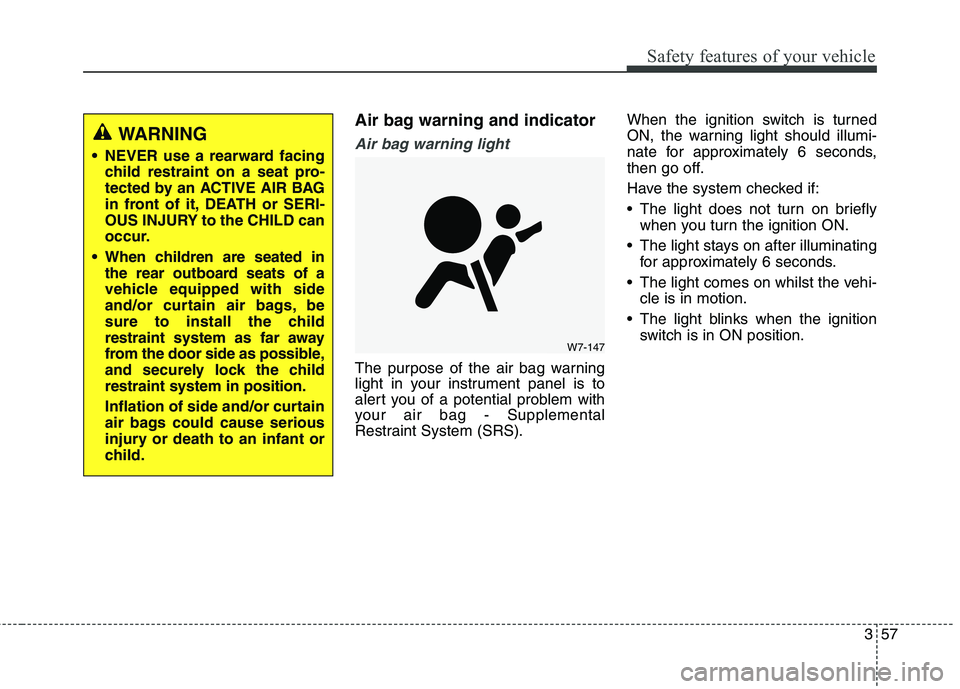
357
Safety features of your vehicle
Air bag warning and indicator
Air bag warning light
The purpose of the air bag warning
light in your instrument panel is to
alert you of a potential problem with
your air bag - Supplemental
Restraint System (SRS).When the ignition switch is turned
ON, the warning light should illumi-
nate for approximately 6 seconds,
then go off.
Have the system checked if:
The light does not turn on briefly
when you turn the ignition ON.
The light stays on after illuminating for approximately 6 seconds.
The light comes on whilst the vehi- cle is in motion.
The light blinks when the ignition switch is in ON position.
W7-147
WARNING
NEVER use a rearward facing child restraint on a seat pro-
tected by an ACTIVE AIR BAG
in front of it, DEATH or SERI-
OUS INJURY to the CHILD can
occur.
When children are seated in the rear outboard seats of a
vehicle equipped with side
and/or curtain air bags, be
sure to install the child
restraint system as far away
from the door side as possible,
and securely lock the childrestraint system in position.
Inflation of side and/or curtain
air bags could cause serious
injury or death to an infant or
child.
Page 80 of 723
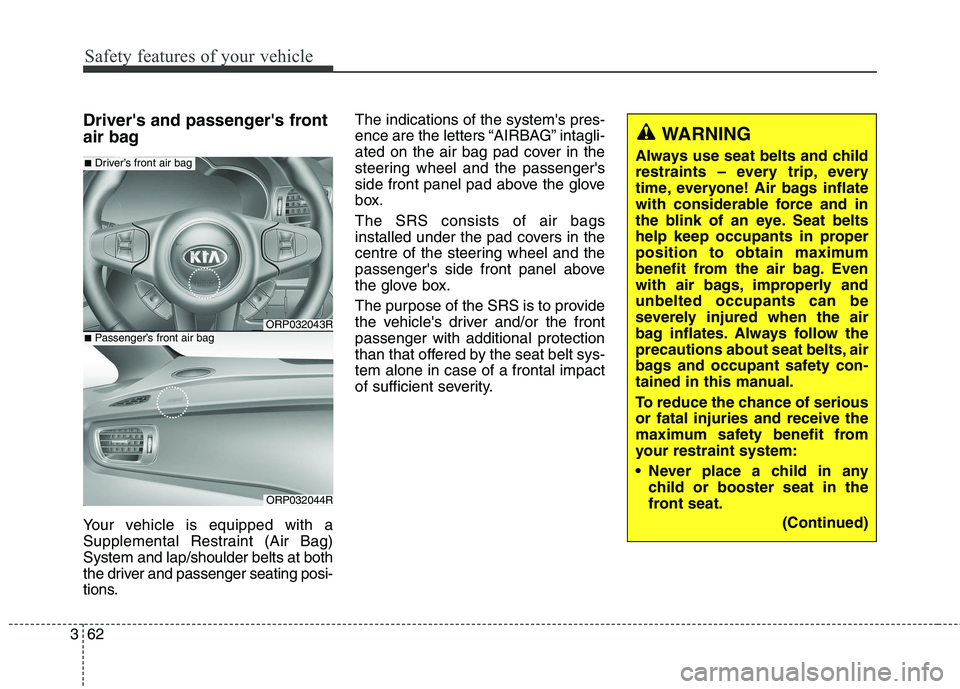
Safety features of your vehicle
62
3
Driver's and passenger's front
air bag
Your vehicle is equipped with a
Supplemental Restraint (Air Bag)System and lap/shoulder belts at both
the driver and passenger seating posi-
tions. The indications of the system's pres-
ence are the letters “AIRBAG” intagli-
ated on the air bag pad cover in the
steering wheel and the passenger's
side front panel pad above the glove
box. The SRS consists of air bags
installed under the pad covers in the
centre of the steering wheel and the
passenger's side front panel above
the glove box.
The purpose of the SRS is to provide
the vehicle's driver and/or the frontpassenger with additional protection
than that offered by the seat belt sys-tem alone in case of a frontal impact
of sufficient severity.
ORP032043R
■
Driver’s front air bag
ORP032044R
■Passenger’s front air bag
WARNING
Always use seat belts and child
restraints – every trip, every
time, everyone! Air bags inflate
with considerable force and in
the blink of an eye. Seat belts
help keep occupants in proper
position to obtain maximum
benefit from the air bag. Even
with air bags, improperly andunbelted occupants can be
severely injured when the air
bag inflates. Always follow the
precautions about seat belts, air
bags and occupant safety con-
tained in this manual.
To reduce the chance of serious or fatal injuries and receive the
maximum safety benefit from
your restraint system:
Never place a child in any child or booster seat in the
front seat.
(Continued)
Page 81 of 723
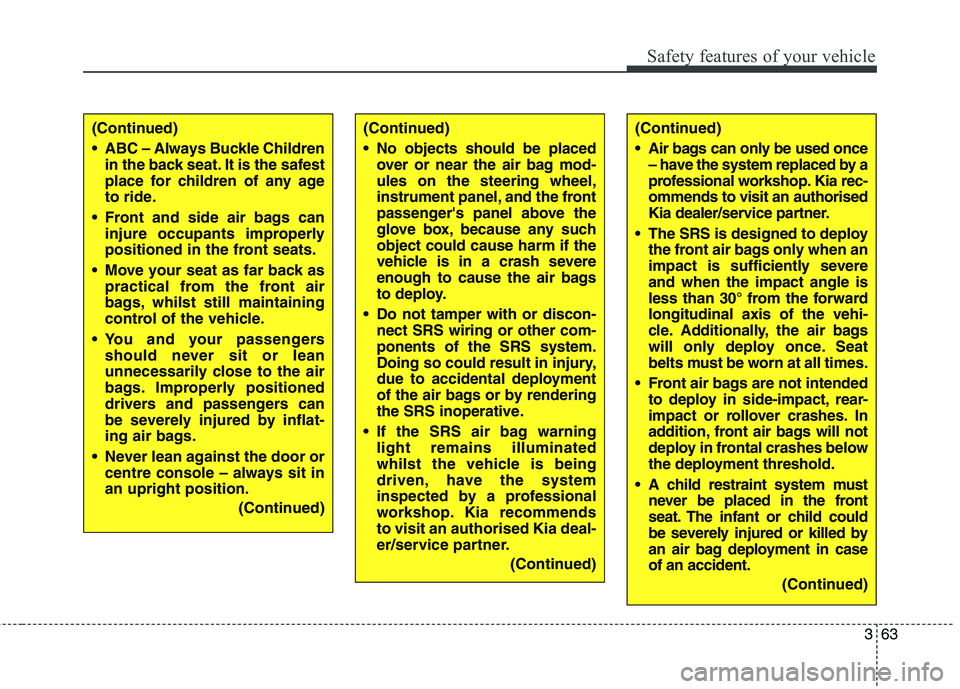
363
Safety features of your vehicle
(Continued)
ABC – Always Buckle Childrenin the back seat. It is the safest
place for children of any age
to ride.
Front and side air bags can injure occupants improperly
positioned in the front seats.
Move your seat as far back as practical from the front air
bags, whilst still maintaining
control of the vehicle.
You and your passengers should never sit or lean
unnecessarily close to the air
bags. Improperly positioned
drivers and passengers can
be severely injured by inflat-
ing air bags.
Never lean against the door or centre console – always sit inan upright position.
(Continued)(Continued)
No objects should be placedover or near the air bag mod- ules on the steering wheel,
instrument panel, and the front
passenger's panel above the
glove box, because any suchobject could cause harm if the
vehicle is in a crash severe
enough to cause the air bags
to deploy.
Do not tamper with or discon- nect SRS wiring or other com-ponents of the SRS system.
Doing so could result in injury,
due to accidental deployment
of the air bags or by rendering
the SRS inoperative.
If the SRS air bag warning light remains illuminated
whilst the vehicle is being
driven, have the system
inspected by a professional
workshop. Kia recommendsto visit an authorised Kia deal-
er/service partner.
(Continued)(Continued)
Air bags can only be used once– have the system replaced by a
professional workshop. Kia rec-ommends to visit an authorised
Kia dealer/service partner.
The SRS is designed to deploy the front air bags only when an
impact is sufficiently severeand when the impact angle is
less than 30° from the forwardlongitudinal axis of the vehi-
cle. Additionally, the air bags
will only deploy once. Seat
belts must be worn at all times.
Front air bags are not intended to deploy in side-impact, rear-
impact or rollover crashes. In
addition, front air bags will not
deploy in frontal crashes below
the deployment threshold.
A child restraint system must never be placed in the front
seat. The infant or child could
be severely injured or killed by
an air bag deployment in caseof an accident.
(Continued)
Page 82 of 723
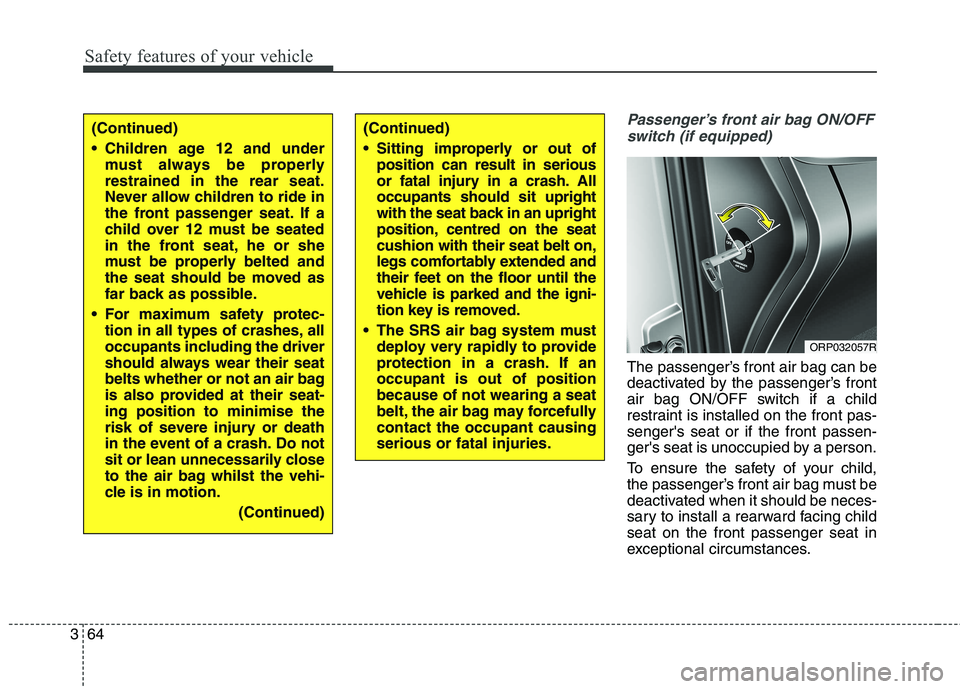
Safety features of your vehicle
64
3
Passenger’s front air bag ON/OFF
switch (if equipped)
The passenger’s front air bag can be
deactivated by the passenger’s front
air bag ON/OFF switch if a child
restraint is installed on the front pas-senger's seat or if the front passen-
ger's seat is unoccupied by a person.
To ensure the safety of your child,
the passenger’s front air bag must be
deactivated when it should be neces-
sary to install a rearward facing childseat on the front passenger seat in
exceptional circumstances.
(Continued)
Children age 12 and under must always be properly restrained in the rear seat.
Never allow children to ride in
the front passenger seat. If a
child over 12 must be seated
in the front seat, he or she
must be properly belted and
the seat should be moved as
far back as possible.
For maximum safety protec- tion in all types of crashes, all
occupants including the driver
should always wear their seat
belts whether or not an air bag
is also provided at their seat-ing position to minimise the
risk of severe injury or death
in the event of a crash. Do not
sit or lean unnecessarily close
to the air bag whilst the vehi-
cle is in motion.
(Continued)(Continued)
Sitting improperly or out ofposition can result in serious
or fatal injury in a crash. Alloccupants should sit upright
with the seat back in an upright
position, centred on the seatcushion with their seat belt on,
legs comfortably extended and
their feet on the floor until the
vehicle is parked and the igni-
tion key is removed.
The SRS air bag system must deploy very rapidly to provide
protection in a crash. If anoccupant is out of positionbecause of not wearing a seat
belt, the air bag may forcefullycontact the occupant causingserious or fatal injuries.
ORP032057R
Page 85 of 723
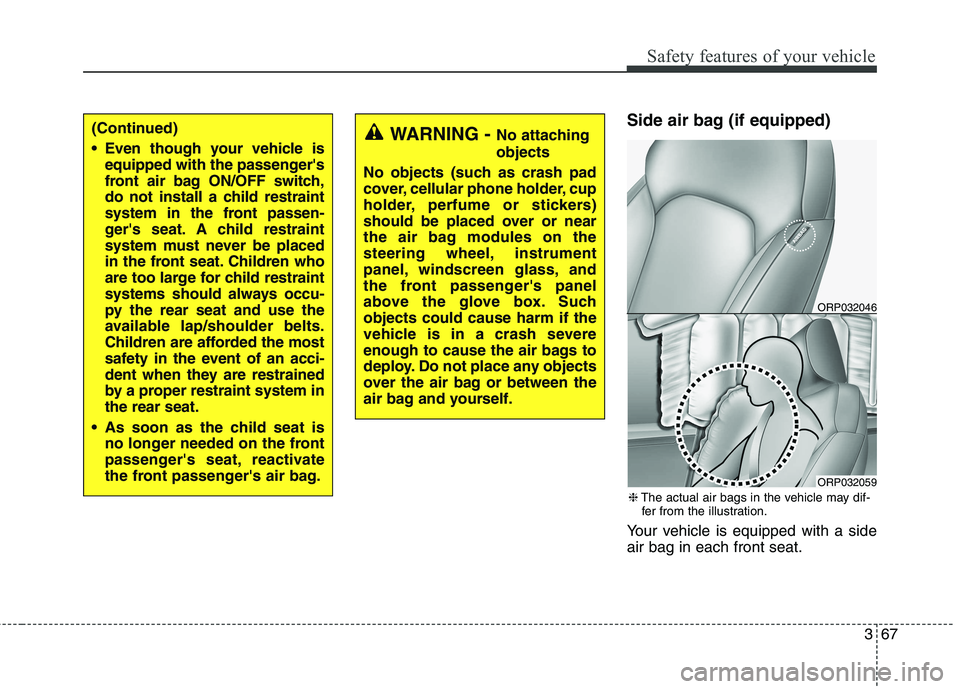
367
Safety features of your vehicle
Side air bag (if equipped)
Your vehicle is equipped with a side air bag in each front seat.(Continued)
Even though your vehicle isequipped with the passenger's
front air bag ON/OFF switch,
do not install a child restraint
system in the front passen-
ger's seat. A child restraint
system must never be placed
in the front seat. Children who
are too large for child restraint
systems should always occu-
py the rear seat and use the
available lap/shoulder belts.
Children are afforded the most
safety in the event of an acci-
dent when they are restrained
by a proper restraint system inthe rear seat.
As soon as the child seat is no longer needed on the front
passenger's seat, reactivate
the front passenger's air bag.WARNING - No attaching objects
No objects (such as crash pad
cover, cellular phone holder, cup
holder, perfume or stickers)
should be placed over or near
the air bag modules on the
steering wheel, instrument
panel, windscreen glass, and
the front passenger's panel
above the glove box. Suchobjects could cause harm if the
vehicle is in a crash severe
enough to cause the air bags to
deploy. Do not place any objects
over the air bag or between the
air bag and yourself.
ORP032046
ORP032059
❈ The actual air bags in the vehicle may dif-
fer from the illustration.
Page 88 of 723
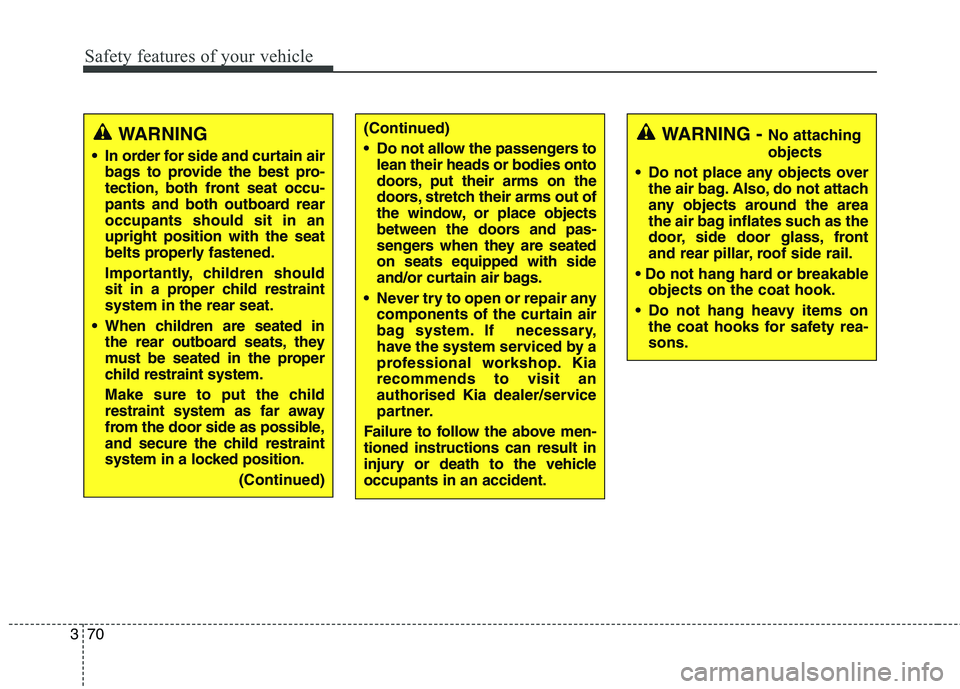
Safety features of your vehicle
70
3
(Continued)
Do not allow the passengers to
lean their heads or bodies onto
doors, put their arms on the
doors, stretch their arms out of
the window, or place objects
between the doors and pas-
sengers when they are seatedon seats equipped with side
and/or curtain air bags.
Never try to open or repair any components of the curtain air
bag system. If necessary,
have the system serviced by a
professional workshop. Kiarecommends to visit an
authorised Kia dealer/service
partner.
Failure to follow the above men-tioned instructions can result in
injury or death to the vehicleoccupants in an accident.WARNING
In order for side and curtain air bags to provide the best pro-
tection, both front seat occu-
pants and both outboard rearoccupants should sit in anupright position with the seat
belts properly fastened.
Importantly, children should
sit in a proper child restraintsystem in the rear seat.
When children are seated in the rear outboard seats, they
must be seated in the proper
child restraint system.
Make sure to put the child
restraint system as far away
from the door side as possible,
and secure the child restraint
system in a locked position.
(Continued)WARNING - No attaching objects
Do not place any objects over the air bag. Also, do not attach
any objects around the area
the air bag inflates such as the
door, side door glass, front
and rear pillar, roof side rail.
objects on the coat hook.
Do not hang heavy items on the coat hooks for safety rea-sons.
Page 95 of 723
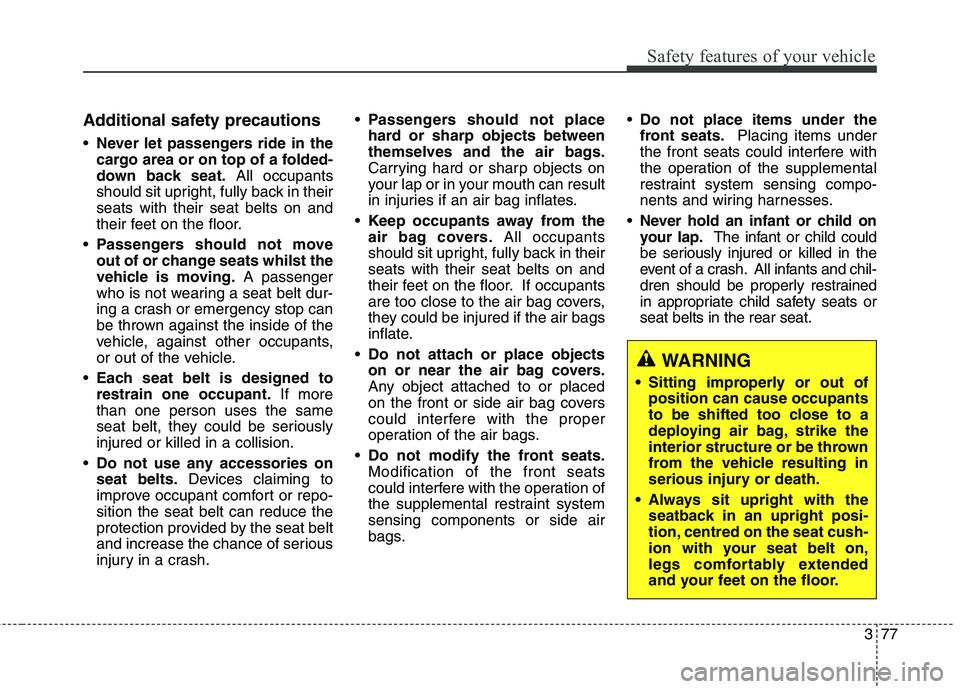
377
Safety features of your vehicle
Additional safety precautions Never let passengers ride in the
cargo area or on top of a folded-
down back seat. All occupants
should sit upright, fully back in theirseats with their seat belts on and
their feet on the floor.
Passengers should not move
out of or change seats whilst the
vehicle is moving. A passenger
who is not wearing a seat belt dur-
ing a crash or emergency stop can
be thrown against the inside of the
vehicle, against other occupants,
or out of the vehicle.
Each seat belt is designed torestrain one occupant. If more
than one person uses the same
seat belt, they could be seriouslyinjured or killed in a collision.
Do not use any accessories onseat belts. Devices claiming to
improve occupant comfort or repo-sition the seat belt can reduce the
protection provided by the seat belt
and increase the chance of serious
injury in a crash.
Passengers should not place
hard or sharp objects between
themselves and the air bags.
Carrying hard or sharp objects on
your lap or in your mouth can result
in injuries if an air bag inflates.
Keep occupants away from the
air bag covers. All occupants
should sit upright, fully back in theirseats with their seat belts on and
their feet on the floor. If occupants
are too close to the air bag covers,
they could be injured if the air bags
inflate.
Do not attach or place objects
on or near the air bag covers.
Any object attached to or placed
on the front or side air bag covers
could interfere with the proper
operation of the air bags.
Do not modify the front seats.Modification of the front seats
could interfere with the operation of
the supplemental restraint systemsensing components or side air
bags.
Do not place items under the
front seats. Placing items under
the front seats could interfere with
the operation of the supplemental
restraint system sensing compo-
nents and wiring harnesses.
Never hold an infant or child on
your lap. The infant or child could
be seriously injured or killed in the
event of a crash. All infants and chil-
dren should be properly restrained
in appropriate child safety seats orseat belts in the rear seat.
WARNING
Sitting improperly or out of position can cause occupants
to be shifted too close to a
deploying air bag, strike the
interior structure or be thrown
from the vehicle resulting in
serious injury or death.
Always sit upright with the seatback in an upright posi-
tion, centred on the seat cush-
ion with your seat belt on,
legs comfortably extended
and your feet on the floor.
Page 715 of 723
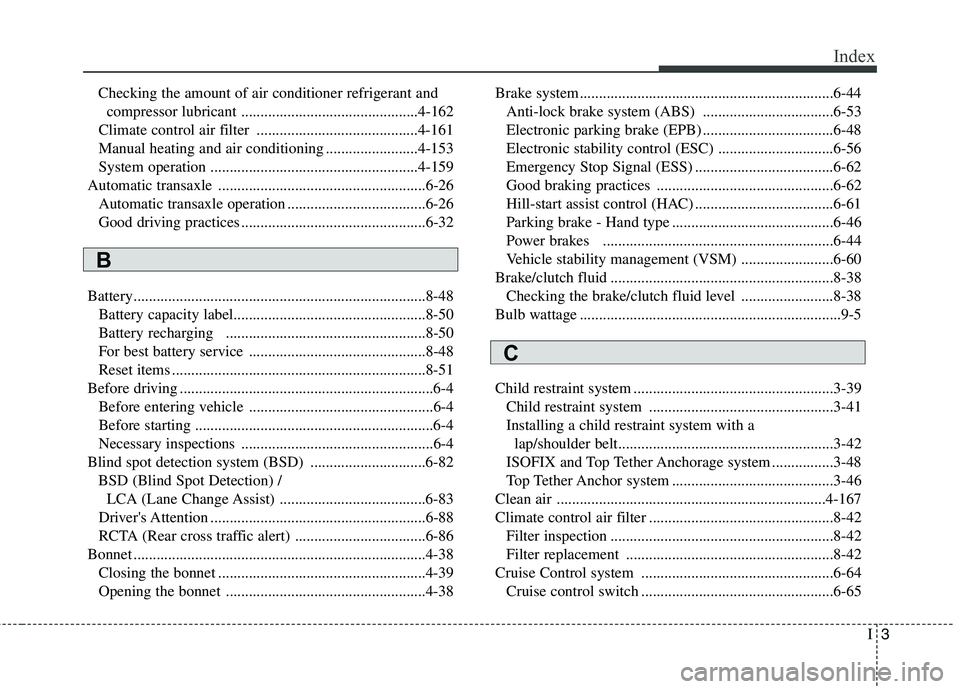
I3
Index
Checking the amount of air conditioner refrigerant and
compressor lubricant ..............................................4-162
Climate control air filter ..........................................4-161
Manual heating and air conditioning ........................4-153
System operation ......................................................4-159
Automatic transaxle ......................................................6-26 Automatic transaxle operation ....................................6-26
Good driving practices ................................................6-32
Battery............................................................................8-48 Battery capacity label..................................................8-50
Battery recharging ....................................................8-50
For best battery service ..............................................8-48
Reset items ..................................................................8-51
Before driving ..................................................................6-4 Before entering vehicle ................................................6-4Before starting ..............................................................6-4
Necessary inspections ..................................................6-4
Blind spot detection system (BSD) ..............................6-82 BSD (Blind Spot Detection) / LCA (Lane Change Assist) ......................................6-83
Driver's Attention ........................................................6-88
RCTA (Rear cross traffic alert) ..................................6-86
Bonnet ............................................................................4-38 Closing the bonnet ......................................................4-39
Opening the bonnet ....................................................4-38 Brake system..................................................................6-44
Anti-lock brake system (ABS) ..................................6-53
Electronic parking brake (EPB) ..................................6-48
Electronic stability control (ESC) ..............................6-56
Emergency Stop Signal (ESS) ....................................6-62
Good braking practices ..............................................6-62
Hill-start assist control (HAC) ....................................6-61
Parking brake - Hand type ..........................................6-46
Power brakes ............................................................6-44
Vehicle stability management (VSM) ........................6-60
Brake/clutch fluid ..........................................................8-38 Checking the brake/clutch fluid level ........................8-38
Bulb wattage ....................................................................9-5
Child restraint system ....................................................3-39 Child restraint system ................................................3-41
Installing a child restraint system with a lap/shoulder belt........................................................3-42
ISOFIX and Top Tether Anchorage system ................3-48
Top Tether Anchor system ..........................................3-46
Clean air ......................................................................4-167
Climate control air filter ................................................8-42 Filter inspection ..........................................................8-42
Filter replacement ......................................................8-42
Cruise Control system ..................................................6-64 Cruise control switch ..................................................6-65
B
C